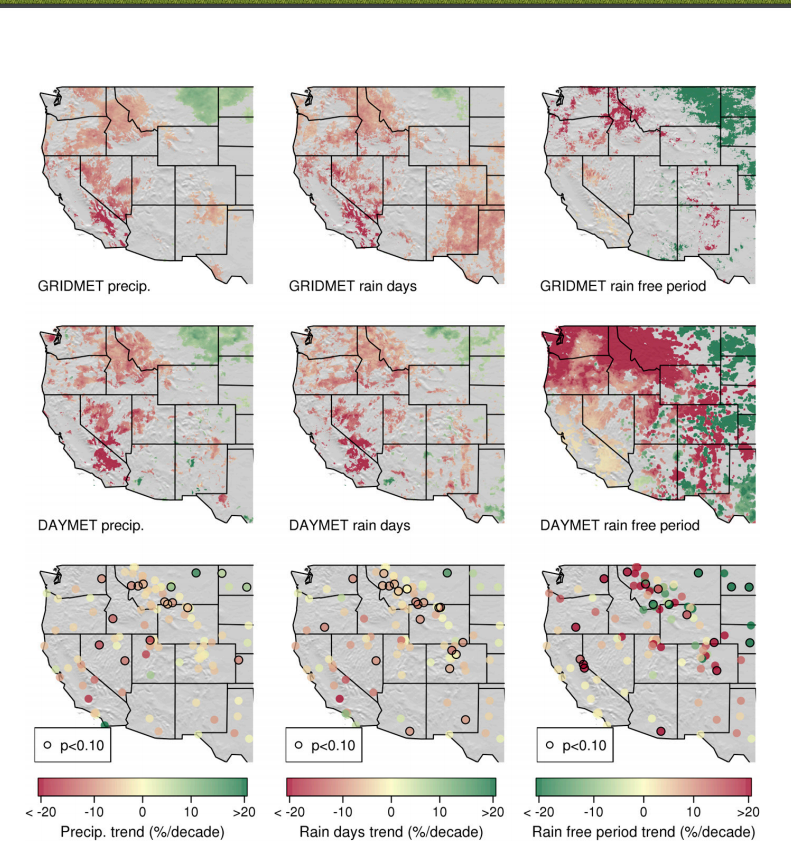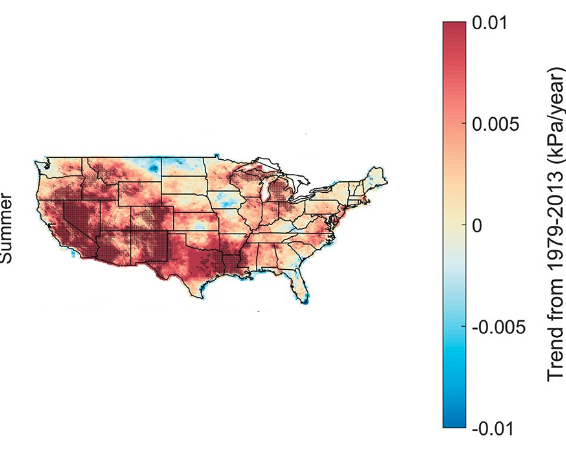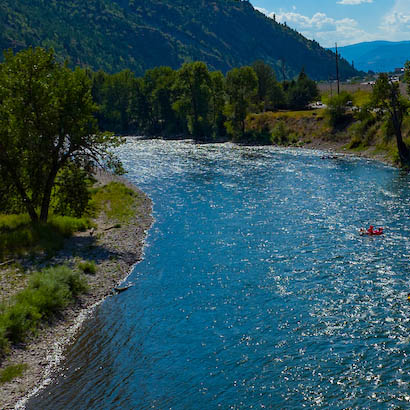How a Drying Atmosphere is Driving Wildfires and May Influence Agricultural Practices
Much of the focus on the increase in wildfires is centered on California (for good reason considering the overwhelming damage seen recently), but the entirety of the western United States have experienced a three-decade-long upturn in wildfire activity (Westerling et al., 2006). Wildfire increases have been generally attributed to warming temperatures and declining snowpacks; however, soil moisture availability strongly influences near-surface air temperature because it controls the amount of available radiative energy that can be dissipated as latent heat - radiative energy that is not spent evaporating water ends up heating the soil and the air. Holden et al. (2018) examined the sensitivity of wildfire area burned to standardized hydrologic and precipitation indices. The results from their study show declining summer precipitation trends and longer interstorm periods, and that these metrics are strongly correlated with burned area extents. The central hypothesis is that even small amounts of summer rain, when distributed evenly throughout the summer, provide relief by periodically dissipating large portions of the heat accumulated in the soil, thus reseting the heat storage and reducing the risk and severity of fires.
Holden et al. (2018) show that declining trends in summer precipitation and longer periods without wetting rain are major contributors to the increase of western US wildfire burned area over the past three decades. While Holden et al. (2018) state there’s no doubt regional temperature increases have increased atmospheric aridity and contributed to increased wildfire activity, they provide evidence that reductions in summer precipitation and the number of wetting rain days (WRD; total days with precipitation greater than or equal to 2.54 mm) may have been the primary driver. Summer precipitation is critical to decrease fuel aridity by adding moisture to woody fuels and soils, cooling temperatures, increasing humidity, and associated cloud cover that reduces incoming solar radiation. The trends across much of western Montana over the past three decades show reductions in summer precipitation and the number of WRD which have resulted in warmer temperatures, higher vapor pressure deficits (VPD), and increased fuel aridity. Additionally, they observed increases in the mean length of continuous rain-free periods from May to September (Fig. 1). Trends across much of eastern Montana and North Dakota, however, show the opposite; increases in summer precipitation and the number of WRD (Fig. 1).

Simultaneous to the finding of declining summer precipitation by Holden et al (2018), Ficklin and Novick (2017) found an increase in atmospheric aridity over much of the western United States during the summer months. These authors examined historic and projected changes in vapor pressure deficit (VPD) across the continental US (difference between the water vapor the air can hold at saturation,es, and the actual amount of water vapor, ea). Their results suggest a continental-scale drying of the US atmosphere. Figure 2 shows seasonal trends from 1979-2013 of summer VPD, which reveal similar spatial patterns of atmospheric drying across western Montana, interestingly also showing and a wetting of the atmosphere over eastern Montana and North Dakota (Fig.2).

The results from these two studies have important implications for Montana water resource managers and farmers. The continental divide seems to be an important boundary separating areas that are getting dryer from areas that are getting wetter. With climate change increasing Montana’s average temperatures and declining mountain snowpacks, the decrease in summer precipitation across western Montana may change farmers planting, irrigation, and harvesting practices. Eastern Montana farmers may see benefits from the changing climate, even if streamflows decrease as a result of decreased snowpack in the Rocky Mountains. These are questions our team is currently addressing. Our project aims to better inform water managers and farmers to help sustain water resources and drive food security into the future under our changing climate.
Please contact Zachary H. Lauffenburger/ Marco Maneta with any questions.
References:
Ficklin DL, Novick KA (2017) Historic and projected changes in vapor pressure deficit suggest a continental-scale drying of the United States atmosphere. J. Geophys. Res. Atmos. 122:2061-2079.
Holden ZA, Swanson A, Luce CH, Jolly WM, Maneta M, Oyler JW, Warren DA, Parsons R, Affleck D (2018) Decreasing fire season precipitation increased recent western US forest wildfire activity. Proceedings of the Natinal Academy of Sciences 115(36):349-357. https://doi.org/10.1073/pnas.1802316115
Westerling AL, Hidalgo HG, Cayan DR, Swetnam TW (2006) Warming and earlier spring increase western U.S. forest wildfire activity. Science 313:940–943.
